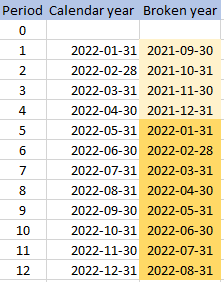This article is part of the article series:
API Best PracticesGood to know: There is a Postman collection in the attachment of this article with ready-to-use examples of the XML requests that are mentioned in this article.
Before you can post transactions you should know about the period table in Twinfield. The period table can have multiple configurations:
- Calendar year (12 months / 4 quarters / 52 weeks)
- Broken year (12 months / 4 quarters / 52 weeks)
- Other
In the period table you will see a comparison between a calendar year and a broken year. Both use 12 periods. One period for each calendar month.
Good to know: The dates in the column are year-month-day. Each date represents the date on which the period ends. The next period will start the day after.

You can download all the periods of a specific year by using the request below. You can use the request named ‘Request periods for a specific year’ in the Postman collection in the attachment of this article.
 Important:
Important: We recommend downloading the period table for each relevant year. Keep in mind that the end user can change the periods after you have downloaded them.
Good to know: You must always use <date> to specify the transaction date while posting a new transaction. If you don't use <period> then Twinfield will look up the date in the period table. If you do use <period> then Twinfield will post the transaction in the period that you specified.
Good to know: Always write periods as yyyy/pp. For example: 2022/08



